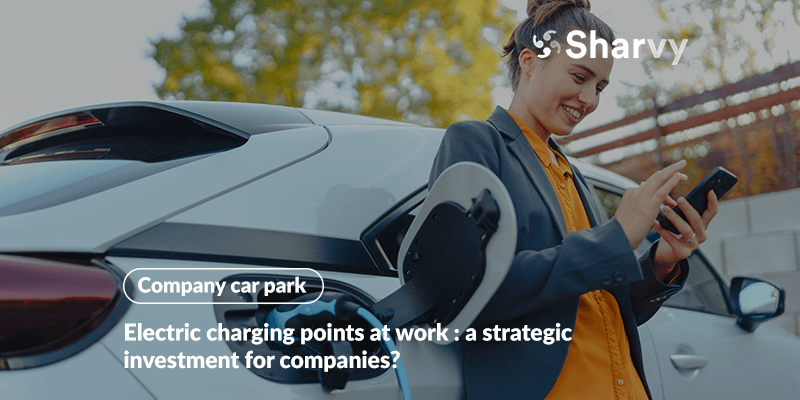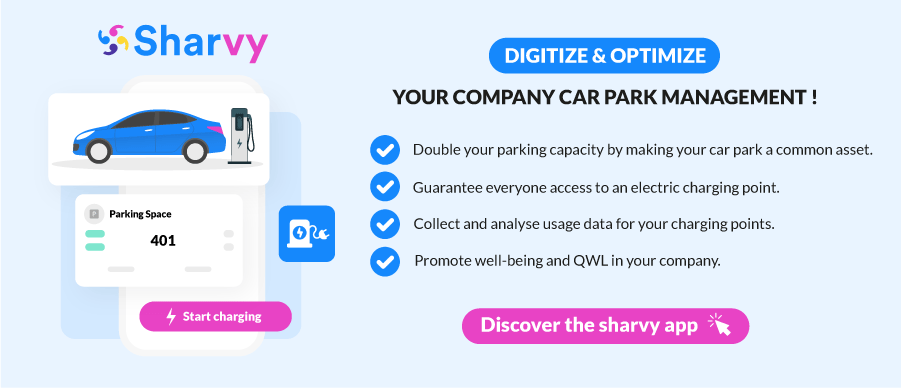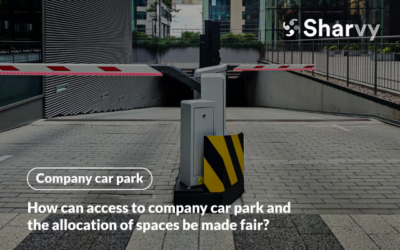From January 2025, all businesses in France will have to install charging points in their car parks. Seen as a constraint by some, this legal obligation could in fact prove to be a golden opportunity for forward-thinking companies. What if this infrastructure, imposed by law, became a strategic lever for attracting talent, boosting employee commitment, and even strengthening your brand image?
In this article, we explore why the charging point should not just be seen as an extra line in your budget, but as a high-potential investment capable of positioning your company at the forefront of tomorrow’s challenges! Focus.
Why install electric charging points at work? What’s at stake for companies?
1. A legal obligation from 2022.
From 1er June 2022, all new non-residential buildings with more than ten parking spaces must have at least one charging point and cable trays for one in five (20%) of the total spaces.
At the same time, all non-residential buildings undergoing major renovation with more than ten parking spaces must also have at least one charging point and cable trays for one in five spaces.
In concrete terms, for every 20 parking spaces, a charging point must be installed, with the specific requirement that at least one space equipped with a charging point must be accessible to people with reduced mobility (PRM).
This measure, which is part of an ambitious government initiative, means that companies will have to anticipate the new needs of their employees, who are increasingly opting for electric vehicles.
2. A response to new employee expectations.
Nowadays, many fast-charging stations are available at motorway service areas, they only meet the needs of 10% of electric vehicle drivers. In reality, 90% of charging is carried out at home and at the workplace, which underlines the importance of companies equipping themselves with charging points to support this change in mobility.
Meeting this demand is now one of the key expectations of employees, who are looking for an employer capable of supporting their transition to more sustainable mobility. By offering them the possibility of recharging their vehicle at work, you are demonstrating that you are both proactive and attentive to modern expectations.
This approach becomes a strategic asset for attracting talent that is sensitive to environmental issues. It also reinforces your image as a visionary employer, capable of offering a working environment that combines well-being, practicality and shared values.
3. A visible commitment to the energy transition.
At a time when actions speak louder than words, the charging points in your company car park become tangible markers of your commitment to the environment. They show your customers, partners and employees that your company is taking an active part in the energy transition, far beyond the rhetoric.
By integrating these facilities, you are showing that your organisation is not simply complying with legal obligations, but is taking the lead. What’s more, this investment strengthens your credibility in the ecological transition & positions your company as a player for change.
The financial & strategic benefits of electric charging points at work.
1. Make your installation profitable in the long term.
What if each recharging session became a financial asset for your company? Installing charging points in your car park not only meets the needs of your employees, it also represents an opportunity to make a long-term return on your investment.
By opting for paid recharging, you can turn each session into a source of income. Your employees, equipped with personalised badges, can access the charge points, and thanks to the Sharvy solution, you can easily distinguish between internal recharges and those of external visitors, thus adjusting billing according to profile.
For example, employees benefit from preferential rates, while external visitors and customers are charged an appropriate rate, guaranteeing a return on investment.
Sharvy also offers real-time monitoring of consumption, enabling you to track each session, from duration to associated costs. This level of supervision helps you to anticipate demand and adjust your offer according to peak times, as well as the specific needs of your electric fleet.
2. Increase the value of your premises with charging stations.
Finally, did you know that installing charging stations can significantly increase the perceived value of your premises?
In a context where electric mobility is developing rapidly, the presence of recharging points is becoming a major asset for companies looking for modern, eco-responsible offices. Recent real estate studies show that premises equipped with charging points are worth an average of 5 to 10% more when resold or rented out than buildings that are not equipped.
For office buildings and logistics sites, this added value is becoming a powerful argument in a market where demand for sustainable infrastructure is growing strongly.
How can you successfully install and manage your electric charging points at work?
1. Choose the electric charging points that meet your team’s needs.
Clearly, each charging point is designed to meet different needs in terms of parking time & charging frequency.
Fast charging points (DC), which can recharge a vehicle in 30 minutes to 1 hour, are ideal for companies where employees are on the move, making numerous journeys during the day from one meeting to another.
On the other hand, if the vehicles are parked for an entire day (for example, employees who work from 9am to 6pm), installing fast charging points would be a loss of efficiency. Standard (AC) charging points, which take an average of 4 to 8 hours to fully recharge, are much more suitable for this type of parking.
What’s more, fast charging points are much more expensive to install and maintain than standard ones. If your employees leave their vehicles in the company car park for a long time, there’s no point choosing a fast charging point that won’t be used to its full potential!
They’ll probably prefer a charging point that better matches their work rhythm, with slow but complete recharges, without having to worry about the speed of the recharge.
2. Optimise the installation & management of your electric charging points with Sharvy.
Sharvy can help you install charging stations adapted to your company car park, whether for a complete project (from installation to management) or for the management of existing stations. If your car park is not yet equipped, Sharvy will take charge of the design, installation and choice of appropriate charging points.
Once the terminals have been installed in your car park, the Sharvy solution can be used by all your employees. It allows them to reserve a parking space equipped with a charging point on a specific day, and then to control charging (start & stop) remotely, once on site.
Your employees can also benefit from smoother access control to the car park. Thanks to Sharvy, only people with a reservation via the app will be able to access the car park & unlock a charging point, guaranteeing increased security.
At the same time, your company’s solution administrators can analyse consumption trends, spot inefficiencies & react quickly to malfunctions with instant alerts. Indicator lights on the kiosks show their status, and simple maintenance actions, such as updating firmware and rebooting the kiosk, can be carried out directly from the application. In this way, Sharvy makes it easier for your business to manage its kiosks, including maintenance and optimisation.
If you’re curious to find out more, ask for a demonstration of the solution!
3. Anticipate the future of mobility in your company.
There’s no doubt about it : the future of mobility is changing fast, and it’s crucial for your business to adapt now to the changes ahead. By anticipating the recharging needs of electric vehicles, you’re also preparing your infrastructure for the new demands of sustainable mobility.
What’s more, by installing shared charging points and optimising their management, you’re offering your employees a modern, flexible solution that’s in line with environmental concerns. As well as responding to the energy transition, this will help prepare your company for future developments, such as the rise of electric vehicle fleets and the integration of new technologies, such as bi-directional charging stations (V2G).
NB : a V2G (Vehicle to Grid) charging point works like a conventional charging point, but also recovers the energy stored in the vehicle’s battery and feeds it back into the grid to power other devices. In this way, it transforms the battery into a genuine energy storage device, offering greater flexibility.
By taking the lead, you can position your company as a responsible and innovative player, ready to meet tomorrow’s expectations.
In conclusion
At a time when electric vehicles are gaining in popularity, anticipating future needs today will help you stay competitive and offer your employees a modern, attractive company car park.
After all, it’s one of the first impressions your employees and visitors will have. By offering easy access to your recharging infrastructure, you’re positioning yourself as a responsible player when it comes to environmental issues, and you’re strengthening your employer brand.
Got a question? Check the following FAQ !
Can electric charging points at work attract new talent?
Of course. Installing charging points can attract new talent, particularly those who own electric & plug-in hybrid vehicles. By offering a recharging infrastructure in the workplace, you are responding directly to the needs of these employees, while sending out a strong message about your company’s commitment to the energy transition. This shows that you are at the forefront of innovation, that you support environmentally-friendly practices and that you offer a working environment that is adapted to the new expectations of sustainable mobility.
What is the average lifespan of a charging point, and what happens when it needs replacing?
The average lifespan of a charging point is around 10 to 15 years, but this depends on a number of factors such as daily use, weather conditions and the quality of maintenance. Well-maintained charging points can last longer.
Maintenance contracts often make it possible to plan these replacements smoothly, and certain subsidies, as mentioned above, can reduce the costs of installing new bollards.
Want to find out more? Check out our latest articles!
10 inequalities observed in company car parks!
What inequalities can be observed in company car parks? What impact do they have? What can be done about them? Find the answers here!
Need more parking spaces at work? 6 solutions to consider!
Are you short of parking spaces at work? Do you need internal and external solutions? How do you go about it? Here are our ideas!
How can access to company car park and the allocation of spaces be made fair?
What are the challenges related to company car park access? How can the allocation of spaces be made fair? Answers here!
Subscribe to our newsletter!
Resources
Contact us
+44 117 463 6990






